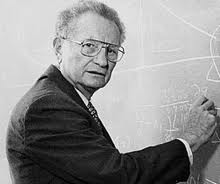Revealed Preference Theory
MICROECONOMICS

|
Revealed Preference Theory |

|
Introduction |
 Paul Anthony Samuelson (May 15, 1915 – December 13, 2009)
Paul Anthony Samuelson (May 15, 1915 – December 13, 2009)
Paul Samuelson has a long list of accomplishments -- A John Bates Clark Medal, a Nobel Prize.Most importantly he is responsible for popularizing Keynesian economics in Post-Second World War.Revealed preference theory was introduced by Nobel Laureate Paul Samuelson in 1938 in the article entitled 'consumption Theory in terms of Revealed Preference'.
As per the theory it is possible to discern consumer behaviour On the basis of variable prices and income. In other words, it has made possible to establish the law of demand without the use of indifference curves on the basis of revealed preference axioms.
According to Samuelson, a consumer with a given income will buy a mixture of products; as his income changes, the mixture of goods and services will also change. It is assumed that the consumer will never select a combination which is more expensive than that which was previously chosen. An economic theory of consumption behavior which asserts that the best way to measure consumer preferences is to observe their purchasing behavior. Revealed preference theory works on the assumption that consumers have considered a set of alternatives before making a purchasing decision. Thus, given that a consumer chooses one option out of the set, this option must be the preferred option.
| Assumptions |
The assumption implies that preferences are transitive.
In other words, if we have bundles A, B, C, ..., Z, and A is revealed preferred to B, which is in turn revealed preferred to C and so on, then it follows that A is revealed preferred to C through Z. Under these hypotheses, economists are able to chart indifference curves which are employed in many models of consumer theory.
| {{{Subsection}}} |
The theory is especially useful in providing a method for analyzing consumer choice empirically. Revealed preference theory deliberately ignores measures of utility and indifference. An empirical utility theory, it superseded cardinal utility in consumer theory.The revealed preference theory is 'behaviourist', while the indifference curve approach is 'introspective'.

|
Activity |
| Write your activity here | |
| Example: {{{Example}}} |
|

|
Self-Assessment Questions (SAQs) {{{n}}} |
| {{{SAQ}}} | |

|
Results |
1.If one bundle is chosen when another could have been chosen, we say that the first bundle is revealed preferred to second.
2.if the consumer is always choosing the most prefered bundles he or she can afford, this means that the chosen bundles must be preferred to the bundles that were affordable but weren't chosen.
3. Observing the choices of consumers can allow us to "recover" or estimate the preferences that lie behind those choices. The more choices we observe,the more precisely we can estimate the underline preferences that generated those choices.
4. The Weak & Strong Axioms of Revealed Preference are necessary conditions that consumer choices have to obey if they are to be considered with the economic model of optimising choice.
Hal R. Varian, Intermediate Microeconomics, Fourth Edition

|
Key Terms |

|
Further Readings |
Source: P.A. Samuelson,’A note on the Pure Theory of Consumers’ Behaviour’, Econometrica NS.5(1938) Varian, H. (1992) Microeconomic Analysis, Third edition, New York: Norton, Section 8.7



